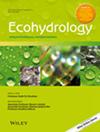Observation and Simulation of Sap Flux Densities for Three Tree Species in the Humid Region of China
Abstract
Tree transpiration plays an important role in the hydrological cycle and largely determines the availability of watershed water resources. The Hanjiang River Basin is the source of the middle route of the south-to-north water diversion project; understanding the characteristics of tree transpiration in the basin and its key controlling factors is of great importance for sustainable water resources management of the region. In this study, we measured the sap flux density as a surrogate of transpiration for three representative tree species (oak, poplar and pine) from January 2021 to December 2023 in the Hanjiang River Basin. Results showed that incoming short-wave radiation (Rsi) and vapour pressure deficit (VPD) are the major factors controlling daytime sap flux density. The nighttime sap flux density generally correlates with the daytime sap flux density for all the tree species. A statistical model was developed for estimating daytime sap flux density based on Rsi and VPD, and the nighttime sap flux density is estimated using its dependence on daytime sap flux density. The proposed model could explain more than 85% of sap flux density variation of the three tree species. Soil water content (SWC) exhibited different impacts on sap flux density among the three tree species, with oak and pine showing clear SWC control, while poplar showed negligible SWC control. Incorporating SWC in the proposed statistical model improved the model performance for oak and pine during dry periods. This study revealed the characteristics of sap flux density of oak, pine and poplar in the Hanjiang River Basin and proposed a statistical sap flux density model for sap flux density simulations in the humid region of China.

 求助内容:
求助内容: 应助结果提醒方式:
应助结果提醒方式:


